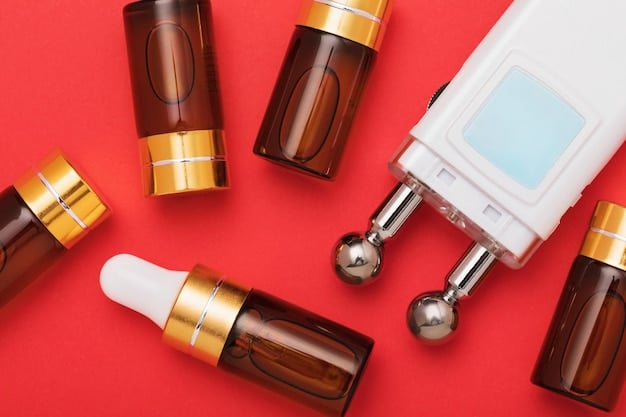Maximize Your Glow: Skincare Layering Guide for 2025

Advertisements
How to Layer Your Skincare Products for Maximum Effectiveness: The 2025 Update emphasizes starting with the thinnest consistency and ending with the thickest, ensuring each product absorbs properly and delivers optimal benefits, addressing concerns about product compatibility and ingredient efficacy for a radiant complexion.
Advertisements
Want to get the most out of your skincare routine? In 2025, mastering how to layer your skincare products for maximum effectiveness is the key to unlocking radiant, healthy skin. This guide will take you through the essential steps and updated tips for a routine that truly works.
Understanding the Basics of Skincare Layering
Advertisements
Skincare layering isn’t just about piling on products; it’s a strategic approach to ensure each formulation works in harmony. The right order maximizes absorption and minimizes potential conflicts. This section explains the core principles behind this technique.
Think of your skin as a canvas. Each layer preps it for the next, creating a synergistic effect. Understanding this concept is the foundation of successful skincare layering.
The Golden Rule: Thin to Thick
Generally, you should apply products from the thinnest to the thickest consistency. This ensures that lighter, water-based products can penetrate the skin before heavier, oil-based ones create a barrier.
Why Order Matters
Applying a thick cream before a serum, for example, can prevent the serum from properly absorbing. This not only wastes product but also reduces the efficacy of your entire routine.

Here’s a quick breakdown of the general order:
- Cleanser
- Toner
- Serums (Water-based first, then oil-based)
- Moisturizer
- Sunscreen (during the day)
Understanding these basics sets the stage for a more tailored and effective skincare routine. Layering correctly ensures that each product delivers its intended benefits, leading to healthier, more radiant skin.
Step-by-Step Guide to Layering Your Skincare
Now that you understand the principles, let’s get practical. This section will guide you through a precise, step-by-step approach to layering your skincare products for the best possible results.
Each step plays a crucial role in prepping and treating your skin. Follow this guide to ensure you’re maximizing the benefits of every product.
Step 1: Cleansing (Morning and Night)
Always start with a clean slate. Cleansing removes dirt, oil, and makeup, allowing subsequent products to penetrate effectively. Choose a cleanser that suits your skin type.
Step 2: Toner (Optional)
Toners help balance your skin’s pH and remove any remaining impurities. If you use a toner, apply it after cleansing and before any serums.
Next, we need to cover the use of serums:
- Serums: Serums are concentrated treatments designed to target specific skin concerns, such as hydration, brightening, or anti-aging. Apply water-based serums before oil-based ones.
- Eye Cream: Apply eye cream before heavier moisturizers to ensure it absorbs properly into the delicate skin around your eyes.
- Moisturizer: Moisturizers hydrate and protect your skin. They should be applied after serums and eye cream to seal in the active ingredients.
- Sunscreen (Daytime): Sunscreen is the final step in your morning skincare routine. It protects your skin from harmful UV rays and prevents premature aging.
This detailed guide ensures that you’re layering your skincare products in the most effective way. Remember to adjust the order and products based on your individual skin needs and concerns.
Ingredient Compatibility: What to Mix and What to Avoid
Ingredient compatibility is crucial for preventing irritation and maximizing efficacy. Certain ingredients work synergistically, while others can clash. This section outlines key considerations for ingredient pairings.
Understanding these interactions can help you avoid common pitfalls and create a routine that delivers the best results without causing adverse reactions.
Winning Combinations
Some ingredients enhance each other’s benefits. For example, Vitamin C and sunscreen offer enhanced protection against sun damage. Hyaluronic acid and moisturizers work together to boost hydration.
Ingredients to Avoid Mixing
Certain combinations can lead to irritation or reduced effectiveness. For instance, mixing retinol with AHAs/BHAs can cause excessive dryness and sensitivity.
Here are some popular combinations to avoid:
- Retinol with Vitamin C
- AHAs/BHAs with Retinol
- Benzoyl Peroxide with Retinol
Patch Testing
If you’re unsure about a new product or combination, perform a patch test. Apply a small amount to a discreet area of your skin and monitor for any adverse reactions before incorporating it into your entire routine.

By understanding ingredient compatibility, you can create a skincare routine that’s both effective and gentle on your skin, avoiding potential irritation and maximizing the benefits of each product.
Adapting Your Routine for Different Skin Types
Not all skincare routines are created equal. Your skin type plays a significant role in determining the best layering approach. This section provides tailored advice for different skin types.
Whether you have oily, dry, combination, or sensitive skin, understanding how to adjust your layering technique is key to achieving optimal results.
Oily Skin
Focus on lightweight, oil-free products. Avoid heavy creams that can clog pores. Opt for gel-based serums and moisturizers. Incorporate ingredients like salicylic acid to control oil production.
Dry Skin
Hydration is key. Layer hydrating serums, rich moisturizers, and facial oils. Look for ingredients like hyaluronic acid, ceramides, and shea butter. Avoid harsh cleansers that can strip your skin of moisture.
Combination Skin
Address both oily and dry areas. Use lightweight products on the T-zone and richer products on drier areas. Consider multi-masking to target specific concerns in different areas of your face.
Skincare for combination skin made simple:
- Serum Selection: Use serums with lightweight textures that will not add extra oil to skin.
- T-Zone: T-zones need exfoliation to avoid clogged pores.
- Application: When applying products, consider applying to specific areas for best effect.
Sensitive Skin
Choose gentle, fragrance-free products. Avoid harsh exfoliants and potential irritants. Patch test new products before incorporating them into your routine. Look for soothing ingredients like chamomile and aloe vera.
By tailoring your skincare routine to your specific skin type, you can create a layering approach that addresses your unique needs and concerns, leading to healthier, more balanced skin.
Common Mistakes to Avoid When Layering
Even with the best intentions, it’s easy to make mistakes when layering skincare products. This section highlights common pitfalls and how to avoid them.
Being aware of these errors can help you refine your technique and ensure that you’re getting the most out of your skincare routine.
Using Too Many Products
More isn’t always better. Overloading your skin with too many products can lead to irritation and clogged pores. Stick to essential steps and avoid unnecessary additions.
Skipping Sunscreen
Sunscreen is non-negotiable, especially when using active ingredients like retinol or AHAs. Skipping sunscreen can negate the benefits of your routine and increase your risk of sun damage.
Not Allowing Products to Absorb
Patience is key. Allow each product to fully absorb before applying the next layer. Rushing the process can prevent products from penetrating properly and reduce their efficacy.
Here is a quick list of mistakes to consider:
- Not cleansing correctly: Use a good cleanser, and make sure face is properly cleaned.
- Application timing: Giving products the proper time to absorb means they can actually take effect.
- Wrong products picked: Picking the wrong products for skin means that you wont get the benefits.
Avoiding these common mistakes can significantly improve the effectiveness of your skincare routine, leading to healthier, more radiant skin.
Future Trends in Skincare Layering (2025 and Beyond)
The world of skincare is constantly evolving, and layering techniques are no exception. This section explores emerging trends and innovations that are shaping the future of skincare layering in 2025 and beyond.
Staying informed about these trends can help you stay ahead of the curve and incorporate the latest advancements into your routine.
Personalized Skincare
Advances in technology are enabling personalized skincare routines tailored to individual needs. AI-powered tools can analyze your skin and recommend specific products and layering strategies.
Multi-Functional Products
Products that combine multiple benefits are becoming increasingly popular. These streamline your routine and reduce the number of layers required.
Sustainability
Consumers are demanding more sustainable skincare options. Brands are responding with eco-friendly packaging and ethically sourced ingredients.
The future of skincare:
- Customizable Products: Skincare that adjusts to enviormental needs.
- At home laser treatment: Safe laser treatments at home will be more common.
- AI analysis: AI tools to pick products perfect for your skin.
By embracing these future trends, you can optimize your skincare routine and achieve even better results, ensuring that your skin stays healthy, radiant, and protected for years to come.
| Key Point | Brief Description |
|---|---|
| 💧 Thin to Thick Rule | Apply products in order of consistency: thinnest to thickest. |
| ☀️ Sunscreen is Key | Always finish your morning routine with sunscreen for protection. |
| 🧪 Ingredient Compatibility | Be mindful of not mixing certain ingredients like retinol and AHAs/BHAs. |
| 🔬 Know Your Skin | Adjust your routine for your skin type to optimize what products you use. |
FAQ
▼
Layering is essential because it ensures each product absorbs properly, delivering active ingredients effectively. It addresses multiple skin concerns simultaneously for best results.
▼
Apply products from thinnest to thickest consistency. Cleanser, toner, serums (water based first, then oil based), moisturizer, and finally sunscreen during the day.
▼
Yes, using too many products can cause irritation, clogged pores, and reduced efficacy. It is best to only use what products you need for your skin type.
▼
Exfoliate 1-3 times per week, depending on your skin’s sensitivity. Over-exfoliating can lead to irritation and dryness, so adjust the frequency as needed.
▼
Avoid mixing retinol with AHAs/BHAs or Vitamin C, as these combinations can cause irritation. Also, avoid mixing benzoyl peroxide with retinol to prevent dryness.
Conclusion
Mastering the art of skincare layering is an investment in your skin’s health and radiance. By understanding the principles, ingredient compatibility, and future trends, you can create a personalized routine that delivers optimal results, ensuring your skin looks its best in 2025 and beyond.





